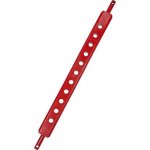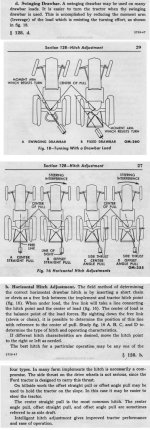Seems to me the nose of the trailer is going to exert downward force if its brakes are locked, regardless of up/down slope.
Haven't you seen the nose of a car drop when the brakes are applied? You think the nose wouldn't drop if driving uphill? Trying to pull a trailer with locked brakes is the same physics. It's not (primarily) the CG moving forward from the axle (or back as you say), it's the forward force exerted at higher elevation than where the tires grip the pavement and are trying to resist motion.
A tractor pulling a trailer is not like a car at all. You really do need to work on vectors and resolution of forces.
With suitable linkages in an "automobile: suspension, You can get the body to rise on deceleration and bank when rounding corners instead of rolling.
Comparing apples to pickles is not a wise thing to do.
Have to agree with California on this, and I don't doubt that he understands vector forces. I think you guys are talking at cross purposes here because of different assumptions. Tell me whether this reasoning makes sense: When you apply the brakes to a car (or tractor) moving
without a tow, its forward momentum, inertia, causes rotation around its center of mass, which is likely above the axles. This translates into vertical ground reaction forces that cause the nose to dip. For the same reason, if the brakes of a trailer under tow were
somehow to lock up
before the brakes of the tow vehicle (e.g., from an electrical malfunction), the front end of the
trailer would dip initially. This assumes of course that the center of mass of the trailer is above its axles, which is pretty safe, especially with a payload. For that few moments, as with a car/tractor, the trailer's rotational force around its center of mass translates to vertical ground reaction forces that momentarily cause the hitch/drawbar to dive, possibly even causing the front of the tow vehicle to rise.
HOWEVER, this is only momentary, as the continued forward momentum of the un-braked tow vehicle then meets the rearward braking forces of the locked trailer wheels. That forward force immediately overtakes the downward force on the hitch/drawbar. And that is where the height of the hitch/drawbar or other attachment point relative to the tow vehicle's center of mass becomes very important. Height of the drawbar (or hitch) of the tow vehicle relative to its center of mass will affect the amount and even direction of rotation around its C of M. If
below the axle of the tractor, the rear wheels are likely to unweight and lose traction (unless the towed load is pulling from well below, as in my example of a truck in a ditch). By contrast, if well above, as with a chain attached to a raised 3-pt drawbar, or looped over a raised implement, the tractor might even flip over backwards.



